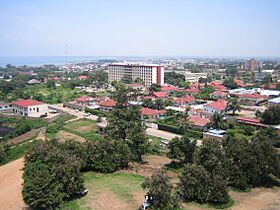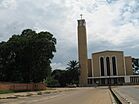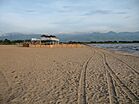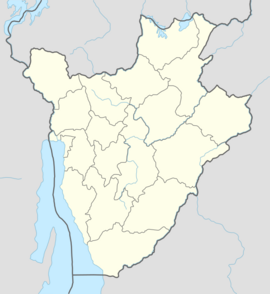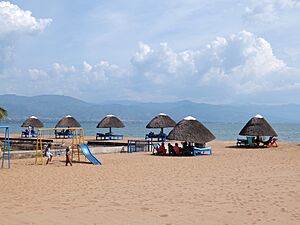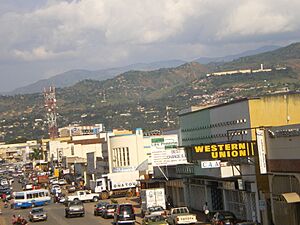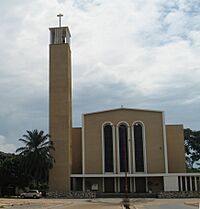Bujumbura facts for kids
Quick facts for kids
Bujumbura
|
|
|---|---|
|
Top: Bujumbura skyline; Middle: Monument to Independence Heroes, Downtown Bujumbura; Regina Mundi Cathedral, Beach at Lake Tanganyika
|
|
| Nickname(s): | |
| Country | |
| Province | Bujumbura Mairie Province |
| Founded | 1871 |
| Area | |
| • Urban | 127 km2 (49 sq mi) |
| Elevation | 774 m (2,539 ft) |
| Population
(2023)
|
|
| • City | 374,809 |
| • Urban | 1,143,202 |
| • Urban density | 9,000/km2 (23,310/sq mi) |
| Time zone | UTC+2 (CAT) |
| Climate | Aw |
Bujumbura (French pronunciation: [buʒumbuʁa]; Kinyarwanda pronunciation: [buʒuᵐbuɾa]), formerly Usumbura, is the economic capital, largest city and main port of Burundi. It ships most of the country's chief export, coffee, as well as cotton and tin ore. Bujumbura was formerly the country's political capital. In late December 2018, Burundian president Pierre Nkurunziza announced that he would follow through on a 2007 promise to return Gitega its former political capital status, with Bujumbura remaining as economical capital and center of commerce. A vote in the Parliament of Burundi made the change official on 16 January 2019, with all branches of government expected to move to Gitega within three years.
Contents
History
Bujumbura grew from a small village after it became a military post in German East Africa in 1889. After World War I it was made the administrative center of the Belgian League of Nations mandate of Ruanda-Urundi. The name was changed from Usumbura to Bujumbura when Burundi became independent in 1962. Since independence, Bujumbura has been the scene of frequent fighting between the country's two main ethnic groups, with Hutu militias opposing the Tutsi-dominated Burundi army.
Geography
Bujumbura is on the north-eastern shore of Lake Tanganyika, the second deepest lake in the world after Lake Baikal. The city also lies at the mouth of the Ruzizi River and the smaller Mutimbuzi, Ntahangwa, Muha and Kanyosha Rivers.
Climate
Bujumbura has a tropical savanna climate (Köppen: Aw) bordering on hot semi-arid (BSh). There are distinct wet and dry seasons; the wet season being from October to April. Being close to the equator, average temperatures in the city vary little over the year, though they are affected by its altitude. The high temperature is around 29 °C (84 °F) and the low around 19 °C (66 °F).
| Climate data for Bujumbura (1961–1990, extremes 1950–1990) | |||||||||||||
|---|---|---|---|---|---|---|---|---|---|---|---|---|---|
| Month | Jan | Feb | Mar | Apr | May | Jun | Jul | Aug | Sep | Oct | Nov | Dec | Year |
| Record high °C (°F) | 34.6 (94.3) |
35.0 (95.0) |
34.0 (93.2) |
35.0 (95.0) |
32.0 (89.6) |
32.0 (89.6) |
33.0 (91.4) |
33.0 (91.4) |
33.8 (92.8) |
34.3 (93.7) |
33.8 (92.8) |
34.8 (94.6) |
35.0 (95.0) |
| Mean daily maximum °C (°F) | 29.1 (84.4) |
29.7 (85.5) |
29.3 (84.7) |
29.2 (84.6) |
29.9 (85.8) |
29.9 (85.8) |
29.2 (84.6) |
30.0 (86.0) |
30.9 (87.6) |
30.1 (86.2) |
29.1 (84.4) |
28.9 (84.0) |
29.6 (85.3) |
| Daily mean °C (°F) | 23.8 (74.8) |
23.8 (74.8) |
23.7 (74.7) |
23.9 (75.0) |
23.9 (75.0) |
23.3 (73.9) |
22.9 (73.2) |
24.0 (75.2) |
24.7 (76.5) |
24.6 (76.3) |
23.4 (74.1) |
23.6 (74.5) |
23.8 (74.8) |
| Mean daily minimum °C (°F) | 19.2 (66.6) |
19.3 (66.7) |
19.3 (66.7) |
19.6 (67.3) |
19.1 (66.4) |
17.6 (63.7) |
17.2 (63.0) |
17.4 (63.3) |
18.6 (65.5) |
19.1 (66.4) |
19.1 (66.4) |
19.1 (66.4) |
18.7 (65.7) |
| Record low °C (°F) | 14.0 (57.2) |
15.4 (59.7) |
14.7 (58.5) |
15.1 (59.2) |
16.2 (61.2) |
13.9 (57.0) |
11.8 (53.2) |
13.0 (55.4) |
14.3 (57.7) |
14.0 (57.2) |
15.9 (60.6) |
15.0 (59.0) |
11.8 (53.2) |
| Average rainfall mm (inches) | 100.3 (3.95) |
85.7 (3.37) |
117.5 (4.63) |
111.9 (4.41) |
56.6 (2.23) |
8.9 (0.35) |
2.7 (0.11) |
13.4 (0.53) |
33.0 (1.30) |
59.0 (2.32) |
97.1 (3.82) |
99.6 (3.92) |
785.7 (30.93) |
| Average rainy days (≥ 0.1 mm) | 16 | 19 | 18 | 18 | 10 | 2 | 1 | 2 | 8 | 15 | 19 | 19 | 147 |
| Average relative humidity (%) | 77 | 75 | 78 | 79 | 76 | 67 | 63 | 60 | 62 | 68 | 76 | 77 | 72 |
| Mean monthly sunshine hours | 167.4 | 158.2 | 176.7 | 165.0 | 210.8 | 255.0 | 272.8 | 251.1 | 213.0 | 189.1 | 150.0 | 164.3 | 2,373.4 |
| Mean daily sunshine hours | 5.4 | 5.6 | 5.7 | 5.5 | 6.8 | 8.5 | 8.8 | 8.1 | 7.1 | 6.1 | 5.0 | 5.3 | 6.5 |
| Source 1: World Meteorological Organization | |||||||||||||
| Source 2: Deutscher Wetterdienst (mean temperatures 1950–1990, humidity 1953–1990, and sun 1951–1990) | |||||||||||||
Administration
Bujumbura is governed by a community council and community administrator. It is further divided into three communes, or neighborhoods, each with its own council and council leader.
Each of the three current communes were created from the 13 former communes (currently sub-communes), due to a 2014 reorganization, which in turn are further sub-divided into villages or zones:
- Commune of Muha
- Kanyosha
- Quarters: Gisyo-Nyabaranda, Gisyo, Musama I, Musama II, Musama III, Musama IV, Musama V, Nyabugete, Kizingwe-Bihara, Nkenga-Busoro, Ruziba, Kajiji
- Kinindo
- Quarters: Kibenga, Kinanira I, Kinanira II, Kinanira III, Kinanira IV, Kinindo, Zeimet-OUA
- Musaga
- Quarters: Gasekebuye-Gikoto, Gitaramuka, Kamesa, Kinanira I, Kinanira II
- Kanyosha
- Commune of Mukaza
- Buyenzi
- Quarters: I, II, III, IV, V, VI, VII
- Bwiza
- Quarters: Bwiza I, Bwiza II, Bwiza III, Bwiza IV, Kwijabe I, Kwijabe II, Kwijabe III
- Nyakabiga
- Quarters: Kigwati, Nyakabiga I, Nyakabiga II, Nyakabiga III
- Rohero
- Quarters: Centre Ville, Rohero I - Gatoke, Kabondo, Mutanga-Sud - Sororezo, Asiatique, I.N.S.S, Rohero II, Kiriri-Vugizo
- Buyenzi
- Commune of Ntahangwa
- Buterere
- Quarters: Buterere I, Buterere II A, Buterere II B, Kabusa, Kiyange, Maramvya, Mubone, Mugaruro, Kiyange
- Cibitoke
- Quarters: I, II, III, IV, V, VI, VII
- Gihosha
- Quarters: Gasenyi, Gihosha, Gikungu, Kigobe, Mutanga-Nord, Muyaga, Nyabagere, Taba, Winterekwa
- Kamenge
- Quarters: Gikizi, Gituro, Heha, Kavumu, Mirango I, Mirango II, Songa, Teza, Twinyoni
- Kigobe
- Quarters: Kigobe Nord, Kigobe Sud
- Kinama
- Quarters: Bubanza, Buhinyuza, Bukirasazi I, Bukirasazi II, Bururi, Carama, Gitega, Kanga, Muramvya, Muyinga, Ngozi, Ruyigi, SOCARTI.
- Ngagara
- Quarters: I, II, III, IV, V, VI, VII, VIII, IX, Industriel
- Buterere
Economy
The Port of Bujumbura is the largest port on Lake Tanganyika. Burundi depends on neighboring countries for access to the ocean. Goods may be carried by road via Rwanda, or by the lake and then by road or rail via Tanzania, Congo or Zambia. 80% of Burundi's external trade is carried via the last three routes, using the Port of Bujumbura. The port manages receipt and delivery of exports and imports, whether carried by ship or by truck. As of 2011 more than 90% of cargo handled was imports, of which about 60% entered by ship and 40% by truck.
Bujumbura Central Market was in the city centre, along Rwagasore Avenue. During the 1993 ethnic violence in Burundi, citizens became less likely to travel far from the city centre, and markets in neighbouring communities lost their business to the central market. At dawn on 27 January 2013 a serious fire ravaged the central market. Due to the poor emergency response, the fire lasted for hours, resulting in a serious blow to local exchanges. Hundreds of vendors, local and foreign, lost their goods to the fire and the reported looting.
Sports
Bujumbura is the location for the city's multisport Intwari stadium. Mainly used for football matches, it is the country's largest stadium with 22,000 seats.
The city is also home to many basketball and tennis courts, as well as a multitude of indoor and outdoor swimming pools.
Education
The University of Burundi is in Bujumbura, as are Hope Africa University, Université Paix et Réconciliation, Université des Grands Lacs, Université du Lac Tanganyika, Ecole Normale Supérieure, Université Lumière de Bujumbura, Bujumbura International University (BIU), International University of Equator, International Leadership University of Bujumbura, Université Ntare Rugamba of Bujumbura, Université Sagesse d'Afrique de Bujumbura, Université Martin Luther King, Institut Supérieur de Développement de Bujumbura (ISD), Ecole Nationale d'Administration "ENA", Institut National de Santé Publique "INSP", Institut Supérieur de Gestion des Entreprises "ISGE", Institut Supérieur d'Ingénieurs et Cadres Techniciens en Génie Informatique, Télécommunications et Technologies Avancées "INITELEMATIQUE".
International schools:
- École Belge de Bujumbura (Belgian school)
- École Française de Bujumbura (French school)
- King's School (British school)
- Bujumbura International Montessori School
- Burundi English School (English Language School)
- Cubahiro International School
Transport
The Bujumbura International Airport is situated on the outskirts of the city.
Public transport in Bujumbura mainly consists of taxis and mini-buses, locally known as the Hiace. Public transport vehicles are generally white and blue.
Bujumbura's taxis are abundant all over the city, and are considered the safest form of transportation. There are taxi-motos (motorcycle taxis) and taxis-vélos (bicycle taxis), although they are only available in certain parts of the city.
For long-distance travel, locals prefer to take the many Hiace full-size vans, which travel regularly across Burundi. Bujumbura's main bus terminal is located by the Central Market.
Places of worship
Among the places of worship are predominantly Christian churches and temples: Roman Catholic Archdiocese of Bujumbura (Catholic Church), Province of the Anglican Church of Burundi (Anglican Communion), Union of Baptist Churches in Burundi (Baptist World Alliance), and Assemblies of God. There are also Muslim mosques.
Culture
Bujumbura's main attractions are its many museums, parks and monuments. Museums in the city include the Burundi Museum of Life and the Burundi Geological Museum. Other nearby attractions are the Rusizi National Park, the Livingstone-Stanley Monument at Mugere (where David Livingstone and Henry Morton Stanley visited 14 days after their first historic meeting at Ujiji in Tanzania), the presidential palace and the source of the southernmost tributary of the Nile, described locally as the source of the Nile.
Bujumbura was also home of the independent weekly radio programme Imagine Burundi, the country's first locally produced English-language programme that focused on stories about life in the region. The show was broadcast from September 2010 to August 2013, and recordings are archived on the show's website at imagineburundi.com.
Demographics
Bujumbura is projected to be the fourth fastest growing African continent city between 2020 and 2025, with a 5.75% growth.
Twin towns and sister cities
Bujumbura is twinned with:
 Ubon Ratchathani, Thailand
Ubon Ratchathani, Thailand Corigliano Calabro, Italy
Corigliano Calabro, Italy
Notable people
- Jeanne Gapiya-Niyonzima, activist
See also
 In Spanish: Buyumbura para niños
In Spanish: Buyumbura para niños


